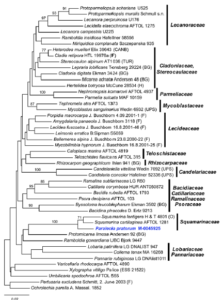Paralecia Brackel, Greiner, Peršoh & Rambold, gen.nov.
Index Fungorum number: IF551012, Facesoffungi number: FoF 00563
Etymology – The genus name ‘Paralecia’ refers to ‘para-’(along with, beside) and to ‘lecia’ (refers to the lecideine apothecia).
Type species – Paralecia pratorum Brackel, Greiner, Peršoh & Rambold
Notes – This new species is characterized by its lichenicolous, endothallic growth, lecideine apothecia, asci with I+ dark blue tube-like apical structure, hyaline, and simple ascospores. Among families with lecanoralean asci (i.e. Lecanoromycetidae), this combination of traits matches with species of the families (sensu Triebel, D. & Bensch, K. 2005 onwards) Aphanopsidaceae, Cladoniaceae, Lecanoraceae, Lecideaceae, Malmidiaceae, Micareaceae, Pannariaceae, Pilocarpaceae, Psoraceae, Ramalinaceae, Stereocaulaceae, Vezdaceae, and the not yet family-assigned genus Myochroidea (Rambold et al. 2001 onwards: lichenicolous growth ignored; thallus growth habit set to crustose endosubstratal, episubstratal, (sub-)crustose, OR(sub-)squamulose, primary photobiont set to chlorophytaceous). However, Myochroidea differs by its well-developed thallus and reddish brown apothecia (black in Paralecia).
According to molecular data, all families, but Stereocaulaceae (incl. Squamarinaceae Hafellner) and Psoraceae (incl. Protomicarea Hafellner), may be discarded as taxa to be considered. The LSU (GenBank Acc. No.: KP224503) and ITS (KP224502) rRNA gene sequences were compared with data in GenBank, using the BLAST function of NCBI (Zhang et al. 2000). The next similar LSU sequence originated from Squamarina cartilaginea (With.) P. James (DQ986763, grade 98.4 %, coverage 100 %, similarity 96.9 %). The ITS sequence of Paralecia pratorum, however, did not reasonably match (similarity<80 %) any sequences in the international sequence databases (INSDC; www.insdc.org). According to LSU phylogeny topology (Fig. 1), which is largely not conflicting with published phylogenies (e.g., Andersen and Ekman 2005; Bendiksby and Timdal 2013; Wedin et al. 2009), P. pratorum is phylogenetically close to the lichenized genus Squamarina (with S. cartilaginea, DQ986763, and S. lentigera (Weber) Poelt, AY756363) and is tentatively considered a member of the Squamarinaceae Hafellner (Hafellner 1984). Within this family, it is unique by its lichenicolous growth, lecideine apothecia, and a more pronounced amyloid tube-structure of the tholus. The ascus type (with a tube-like amyloid structure) is in accordance with that known from Squamarina gypsacea (Sm.) Poelt (Hertel and Rambold 1988). Next related, but with only 91 % similarity (722 out of 795 bp are identical) and without bootstrap support, appears to be Protomicarea limosa (Ach.) Hafellner (AY756332), exhibiting a rather similar combination of apothecial traits (excipulum, pigmentation, ascus, ascospores).
Hitherto, only one record of an undescribed taxon, ‘Lecidea aff. insidiosa’, growing on P. muralis, exists (Nimis and Poelt 1987; Rambold and Triebel 1992). Lecidea insidiosa Th. Fr. (KJ766650), exhibiting a more or less typical Lecanora-type ascus, has meanwhile been combined to Ramboldia insidiosa (Th. Fr.) Hafellner, but clusters in the present LSU tree with Miriquidica complanata (Körb.) Hertel & Rambold (KF562179; generic type of Miriquidica) (Fig. 1). Phylogenetic analysis results further show a closer relationship of the Squamarinaceae Hafellner to Lobariaceae and Pannariaceae, but not to the Stereocaulaceae, which supports the suggestion of Miadlikowska et al. (2014) to resurrect and recircumscribe this family.

Fig. 1 Phylogram generated from Maximum likelihood (PhyxML v. 2.20) analysis based on LSU sequence data.Maximum likelihood bootstrap support values greater than 70 % are indicated above the nodes. Species names are followed by the voucher IDs and the new species is in blue.
Species
